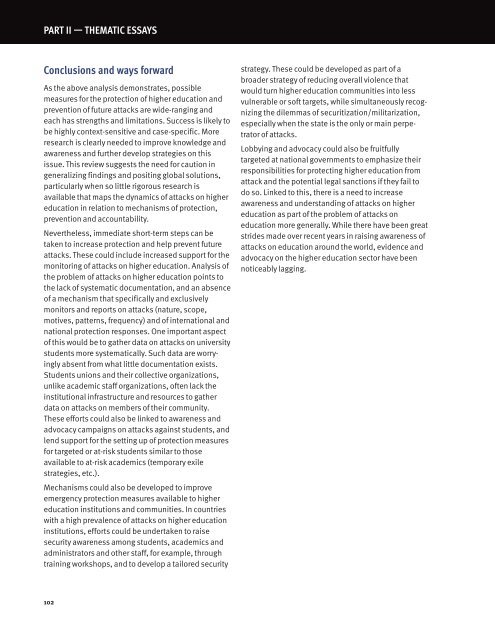eua_2014_full.pdf?utm_content=buffer4a392&utm_medium=social&utm_source=twitter
eua_2014_full.pdf?utm_content=buffer4a392&utm_medium=social&utm_source=twitter
eua_2014_full.pdf?utm_content=buffer4a392&utm_medium=social&utm_source=twitter
- No tags were found...
You also want an ePaper? Increase the reach of your titles
YUMPU automatically turns print PDFs into web optimized ePapers that Google loves.
PART II — THeMATIC eSSAYSConclusions and ways forwardAs the above analysis demonstrates, possiblemeasures for the protection of higher education andprevention of future attacks are wide-ranging andeach has strengths and limitations. Success is likely tobe highly context-sensitive and case-specific. Moreresearch is clearly needed to improve knowledge andawareness and further develop strategies on thisissue. This review suggests the need for caution ingeneralizing findings and positing global solutions,particularly when so little rigorous research isavailable that maps the dynamics of attacks on highereducation in relation to mechanisms of protection,prevention and accountability.Nevertheless, immediate short-term steps can betaken to increase protection and help prevent futureattacks. These could include increased support for themonitoring of attacks on higher education. Analysis ofthe problem of attacks on higher education points tothe lack of systematic documentation, and an absenceof a mechanism that specifically and exclusivelymonitors and reports on attacks (nature, scope,motives, patterns, frequency) and of international andnational protection responses. One important aspectof this would be to gather data on attacks on universitystudents more systematically. Such data are worryinglyabsent from what little documentation exists.Students unions and their collective organizations,unlike academic staff organizations, often lack theinstitutional infrastructure and resources to gatherdata on attacks on members of their community.These efforts could also be linked to awareness andadvocacy campaigns on attacks against students, andlend support for the setting up of protection measuresfor targeted or at-risk students similar to thoseavailable to at-risk academics (temporary exilestrategies, etc.).Mechanisms could also be developed to improveemergency protection measures available to highereducation institutions and communities. In countrieswith a high prevalence of attacks on higher educationinstitutions, efforts could be undertaken to raisesecurity awareness among students, academics andadministrators and other staff, for example, throughtraining workshops, and to develop a tailored securitystrategy. These could be developed as part of abroader strategy of reducing overall violence thatwould turn higher education communities into lessvulnerable or soft targets, while simultaneously recognizingthe dilemmas of securitization/militarization,especially when the state is the only or main perpetratorof attacks.Lobbying and advocacy could also be fruit<strong>full</strong>ytargeted at national governments to emphasize theirresponsibilities for protecting higher education fromattack and the potential legal sanctions if they fail todo so. Linked to this, there is a need to increaseawareness and understanding of attacks on highereducation as part of the problem of attacks oneducation more generally. While there have been greatstrides made over recent years in raising awareness ofattacks on education around the world, evidence andadvocacy on the higher education sector have beennoticeably lagging.102


